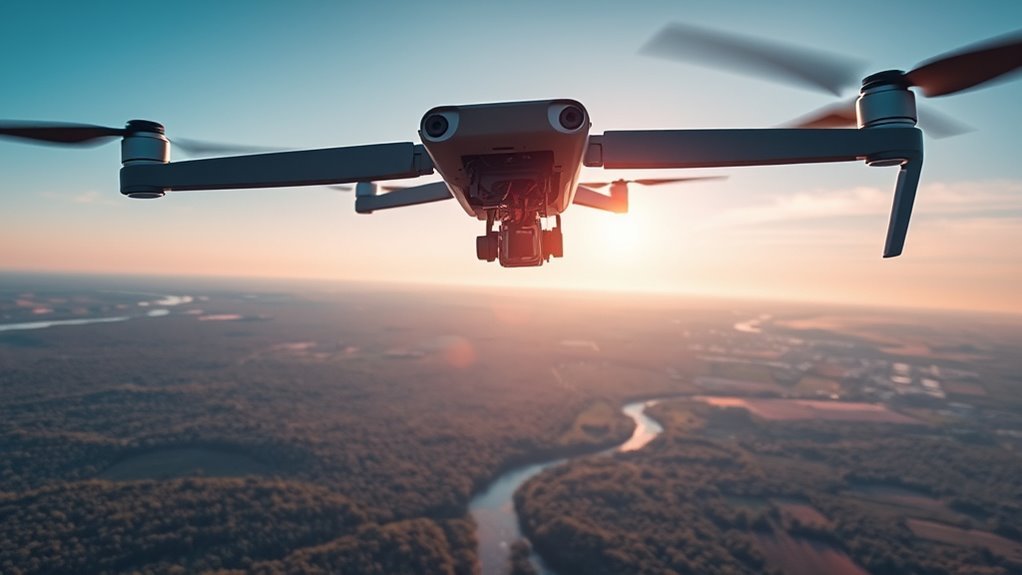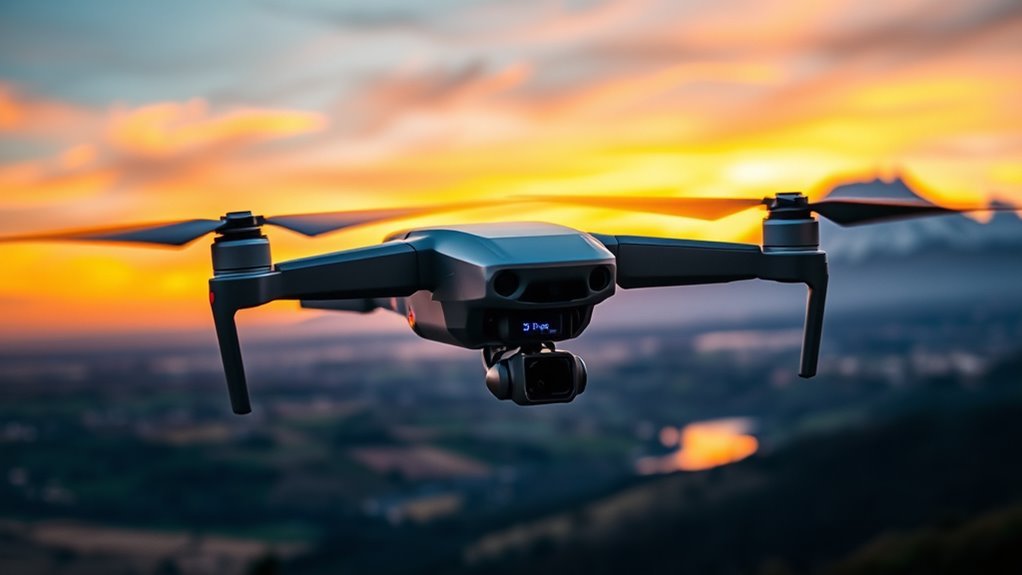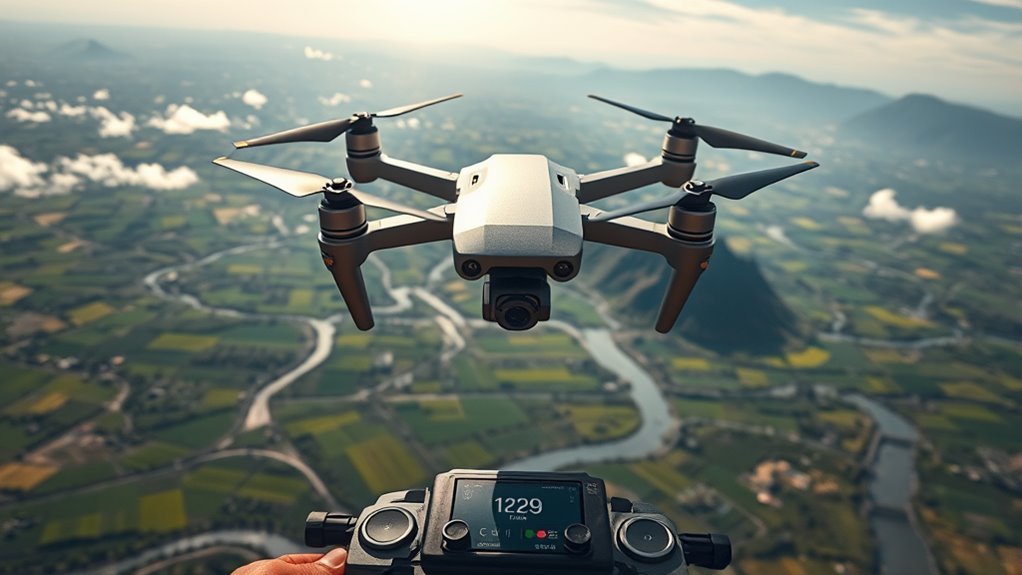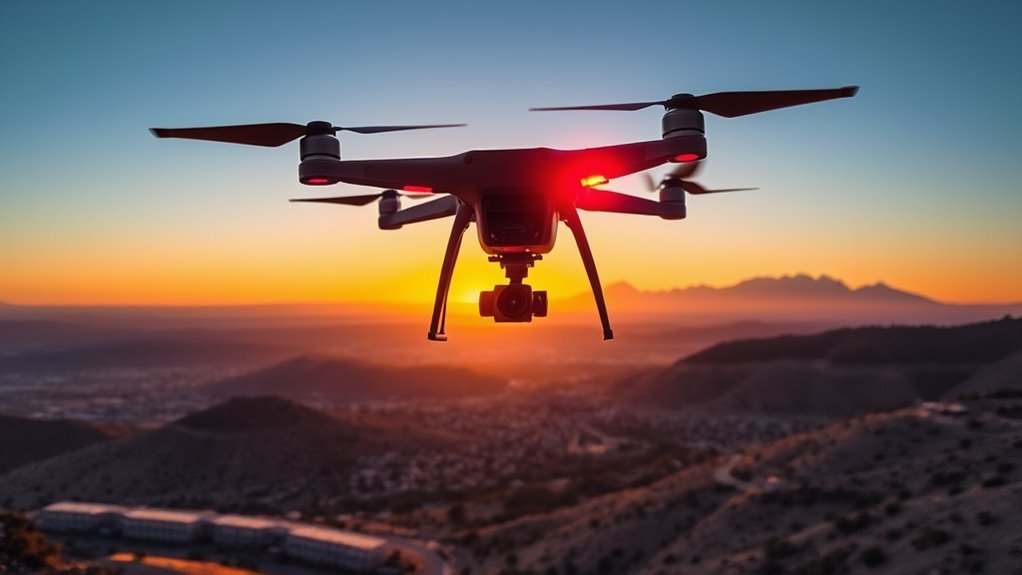You’ll find that a drone’s range depends on multiple factors. Battery capacity and chemistry dictate flight time, while payload weight and aerodynamics impact power consumption. Signal strength between your controller and drone limits operational reach, affected by interference and antenna type. Weather, including wind and temperature, influences stability and battery efficiency. GPS accuracy and navigation algorithms affect positioning, and legal restrictions set flight boundaries. Understanding these elements lets you optimize distance and performance—exploring them further reveals deeper operational insights.
Battery Capacity and Flight Time

Battery capacity directly influences a drone’s flight time, determining how long you can operate the device before needing a recharge. The core technical factor here is battery chemistry, which dictates the energy density—the amount of energy stored per unit weight or volume. Higher energy density batteries, such as lithium polymer (LiPo), enable extended flight durations without appreciably increasing weight. This increased energy storage translates to greater freedom in flight range and mission duration. However, you must consider the trade-offs: batteries with higher energy density may have different discharge rates and thermal stability, affecting performance and safety. To maximize flight time, selecting a battery with ideal chemistry and energy density is essential, as it directly impacts the drone’s ability to sustain power output during operation, ultimately defining how far and how long you can fly.
Payload Weight and Aerodynamics

While optimizing battery capacity extends flight time, the drone’s payload weight and aerodynamic design play a significant role in determining its effective range. When you add weight, especially if payload distribution is uneven, the drone requires more thrust, consuming more energy and reducing range. Proper payload distribution minimizes drag and maintains stability, allowing the motors to operate efficiently. Additionally, the aerodynamic design directly impacts air resistance; a streamlined shape reduces drag force, enabling the drone to conserve energy during flight. You want to balance payload weight with a design that cuts through air smoothly to maximize distance. Neglecting these factors forces your drone to work harder against gravity and wind resistance, limiting how far you can explore freely.
Signal Range and Controller Technology

Even if your drone is optimized for endurance, its operational range is limited by the strength of the signal between the controller and the aircraft. The controller range dictates how far you can fly before losing command, directly impacting your freedom to explore. Several factors influence this:
- Signal Interference: Urban environments, Wi-Fi networks, and other radio frequencies can disrupt the signal, reducing effective range.
- Controller Technology: Advanced controllers using frequencies like 2.4 GHz or 5.8 GHz, and technologies such as frequency hopping, enhance range and resistance to interference.
- Antenna Design: High-gain, directional antennas improve signal focus, extending reach by minimizing losses.
Understanding these elements lets you maximize distance without compromising control, ensuring your drone stays within your command and maintains a stable connection throughout your flight.
Weather Conditions and Wind Impact
You’ll need to account for how wind speed directly affects your drone’s stability and power consumption, reducing its effective range. Temperature variations can alter battery efficiency, impacting flight duration and responsiveness. Additionally, precipitation introduces operational risks and can degrade sensor performance, further limiting your drone’s range capabilities.
Wind Speed Effects
Although drones are designed to handle a range of environmental conditions, wind speed greatly influences their operational range by affecting battery consumption and flight stability. You’ll notice that higher wind speeds increase power draw as your drone works harder to maintain course, especially under wind turbulence. Crosswind effects cause lateral instability, forcing constant corrections that drain energy faster. To optimize your drone’s range in windy conditions, consider these factors:
- Monitor wind speed thresholds specific to your drone model to avoid excessive battery drain.
- Adjust flight paths to minimize exposure to strong crosswinds and turbulent zones.
- Use real-time telemetry to adapt flight parameters dynamically, maintaining efficiency despite changing wind conditions.
Understanding these elements guarantees you maintain freedom to explore without sacrificing flight duration.
Temperature Influence
Wind conditions greatly impact drone performance, but temperature also plays a key role in determining flight range and battery efficiency. You need to understand temperature effects on your drone’s thermal dynamics to enhance its operation. Cold temperatures increase battery internal resistance, reducing capacity and limiting flight time, while excessive heat can accelerate battery degradation and cause thermal throttling. Additionally, air density varies with temperature; colder air is denser, improving lift and propulsion efficiency, whereas warmer air reduces aerodynamic performance. Managing these thermal dynamics guarantees your drone maintains peak power output and stability. By anticipating temperature fluctuations, you can adjust your flight plans accordingly, maximizing range and preserving battery health, ultimately granting you greater freedom and control over your drone’s capabilities.
Precipitation Challenges
When precipitation occurs, it directly affects the drone’s aerodynamic stability and sensor functionality, complicating both control and navigation. Understanding rain interference and moisture impact is essential for maintaining your drone’s range and performance. Here are key challenges precipitation presents:
- Aerodynamic drag increase: Water droplets add drag, reducing flight efficiency and battery life, limiting how far you can go.
- Sensor degradation: Moisture disrupts optical and infrared sensors, impairing obstacle detection and GPS accuracy, which compromises navigation.
- Electronic vulnerability: Persistent moisture exposure risks short circuits and corrosion, potentially causing in-flight failures or forced landings.
Drone Model and Motor Efficiency
Because the drone model dictates the integration of components, its design directly influences motor efficiency and ultimately the drone’s operational range. When selecting or customizing your drone, you must consider how the drone design accommodates different motor types—brushless or brushed motors offer varying power-to-weight ratios and efficiency levels. Brushless motors, favored for their higher efficiency and durability, reduce energy loss, extending flight time and distance. Additionally, the frame’s weight and aerodynamics impact motor load; a streamlined design lessens drag, enabling motors to operate effectively without excessive power consumption. By understanding these interdependencies, you can optimize your drone’s propulsion system to achieve maximum range, granting you the freedom to explore further with confidence while maintaining efficient energy use throughout your flights.
GPS Accuracy and Navigation Systems
You need to understand how GPS signal strength directly influences your drone’s ability to maintain accurate positioning over long distances. The precision of your navigation algorithms determines how effectively your drone interprets satellite data to stay on course. Additionally, satellite coverage density affects the reliability of global positioning, especially in remote or obstructed areas.
GPS Signal Strength
Although drone range largely depends on hardware capabilities, GPS signal strength plays a critical role in ensuring accurate navigation and positioning. When you rely on GPS for precise location data, weak signals can degrade GPS accuracy, leading to navigation errors and limiting how far your drone can effectively fly. Key factors affecting signal strength include:
- Signal interference from buildings, trees, or electronic devices can disrupt the drone’s connection to satellites.
- Atmospheric conditions such as ionospheric disturbances can weaken or delay signals.
- Satellite geometry, referring to the relative positions of satellites, impacts the quality of positional fixes.
Understanding these factors helps you optimize your drone’s operational range, ensuring reliable navigation and maximizing your freedom to explore farther.
Navigation Algorithm Precision
Weak GPS signals can impair your drone’s ability to maintain accurate positioning, but even with strong signals, the precision of routing algorithms determines how effectively your drone interprets that data. Different routing algorithm types—such as Kalman filters or particle filters—process incoming GPS data with varying accuracy. Regular routing algorithm updates enhance your drone’s ability to correct positioning errors, directly impacting flight range and reliability. Here’s a concise comparison:
| Routing Algorithm Type | Key Feature |
|---|---|
| Kalman Filter | Best for linear systems |
| Particle Filter | Handles non-linear uncertainty |
| Extended Kalman Filter | Manages non-linear dynamics |
| Complementary Filter | Combines multiple sensor inputs |
| Routing Updates | Refine algorithms, reduce drift |
Selecting the right algorithm and maintaining updates guarantees your drone flies farther while confidently maneuvering through complex environments.
Satellite Coverage Density
Because satellite coverage density directly influences GPS accuracy, it plays a critical role in determining your drone’s navigation reliability and effective range. Satellite positioning relies on a dense constellation of satellites to provide continuous, precise location data. When coverage gaps occur, your drone’s ability to maintain accurate coordinates diminishes, limiting its operational freedom.
Consider these factors:
- Satellite Constellation Density: Higher density reduces coverage gaps, enhancing positioning accuracy.
- Geographic Location: Urban canyons or remote areas often experience sparse coverage, impacting signal quality.
- Signal Obstruction: Physical barriers like buildings or terrain can create localized coverage gaps, disrupting navigation.
Understanding these elements helps you optimize flight paths, ensuring your drone can confidently explore with minimal risk of losing GPS lock.
Regulatory Restrictions and No-Fly Zones
When operating a drone, you must account for regulatory restrictions and no-fly zones that limit flight range and permissible areas. Regulatory compliance is critical to avoid violations that can ground your drone or lead to penalties. Effective airspace management guarantees safety but imposes boundaries on how far you can fly, especially near airports, military bases, or sensitive locations. Understanding these zones allows you to plan routes that maximize range within legal limits.
| No-Fly Zone Type | Common Restrictions |
|---|---|
| Airports | Prohibited within 5 miles |
| Government Buildings | Restricted airspace, special permits required |
| Urban Areas | Altitude and flight path limitations |
Respecting these factors lets you push your drone’s capabilities without risking legal trouble or safety breaches.

